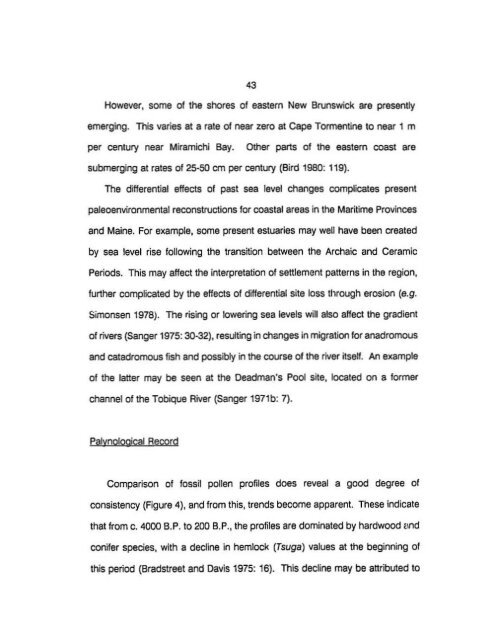CI[)l1:721 - Memorial University of Newfoundland DAI
CI[)l1:721 - Memorial University of Newfoundland DAI
CI[)l1:721 - Memorial University of Newfoundland DAI
Create successful ePaper yourself
Turn your PDF publications into a flip-book with our unique Google optimized e-Paper software.
43<br />
However, some <strong>of</strong> the shores <strong>of</strong> eastern New Brunswick are presently<br />
emerging. This varies at a rale <strong>of</strong> near zero at Cape Tormentine to near 1 m<br />
per century near Miramichi Bay. Other parts <strong>of</strong> the eastern coast are<br />
submerging at rates <strong>of</strong> 25-50 an per century (Bird 1980: 119).<br />
The differential effects <strong>of</strong> past sea level changes complicates present<br />
paleoenvironmental reconstructions for coastal areas in the Maritime Provinces<br />
and Maine. For example, some present estuaries may well have been created<br />
by sea level rise following the transition between the Archaic and Ceramic<br />
Periods. This may affect the interpretation <strong>of</strong> settlement patterns in the region,<br />
further complicated by the effects <strong>of</strong> differential site loss through erosion (e.g.<br />
Simonsen 1978). The rising or lowering sea levels will also affect the gradient<br />
<strong>of</strong> rivers (Sanger 1975: 3Q(32), resulting in changes in migration for anadromous<br />
and catadromous fish and possibty in the course <strong>of</strong> the river itsen. An example<br />
<strong>of</strong> the latter may be seen at the Deadman's Pool site, located on a former<br />
channel <strong>of</strong> the Tobique River (Sanger 1971b: 7).<br />
Palynological Record<br />
Comparison <strong>of</strong> fossil pollen pr<strong>of</strong>iles does reveal a good degree <strong>of</strong><br />
consistency (Figure 4), and from this, trends become apparent. These indicate<br />
that from c. 4000 B.P.to 200 B.P., the pr<strong>of</strong>iles are dominated by hardwood and<br />
conifer species, with a decline in hemlock (Tsuga) values at the beginning <strong>of</strong><br />
this period (Bradstreet and Davis 1975: 16). This decline may be attributed to

















